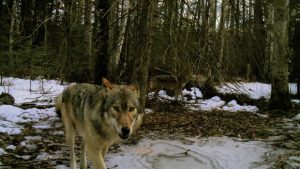
How can they expect to deter depredation if they leave the Carcass onsite? The Ranchers let their cows into rough Terrain… they need to cut down on attractants…. not Provide them!! Call Martorello and ask that these are not counted if they are leaving Attractants in the woods.
Additional depredations documented by Togo wolf pack
August 11, 2018
On August 8, 2018, WDFW was contacted by the wildlife specialist employed by the Stevens and Ferry County sheriff’s offices about a potential wolf depredation on a U.S. Forest Service grazing allotment in the Togo pack wolf territory in Northern Ferry County, near Danville. Later that day, WDFW staff documented a deceased adult cow. During the investigation, staff documented bite lacerations with associated hemorrhaging, signs of a struggle down a steep hill and around the cow carcass, and recent wolf activity in the area. Based on that evidence, they confirmed that the death was a depredation by one or more wolves from the Togo pack.
Due to the remote location and rugged terrain, the cow carcass was left on site. Meanwhile, the livestock producer and his range rider pushed the cattle to a different area of the allotment. The cow had been turned out as part of a cow-calf pair, but the producer and range rider were not immediately able to locate the calf. They are continuing to search.
Throughout the grazing season the producer has used a variety of deterrent measures to protect the livestock. He delayed turnout until late June so the calves would be larger and used Fox lights on his private pasture to deter wolves. Following turnout, he has removed sick or injured cattle from the allotment and deployed one or more range riders each day to help the producer check the cattle. They have moved the cattle when necessary.
On August 9, at about 9:30 p.m., the department was contacted by a WDFW-contracted range rider about another potential wolf depredation in the Togo pack area that injured a 350-pound calf owned by the same producer. The producer and range rider moved the injured calf, and the cow that accompanied it, from the allotment to a holding pen at their residence.
On August 10, WDFW staff and the two counties’ wildlife specialist examined the cow and calf. The cow did not appear to have any injuries, but they documented bite lacerations to both of the calf’s hamstrings and left flank, and puncture wounds and associated hemorrhaging to the left hindquarter and stomach. Based on the evidence and related factors, the investigators confirmed that the calf’s injuries were the result of a wolf depredation. The cow and injured calf were kept at the holding pen for monitoring.
The latest incidents bring the total number of confirmed depredations by the Togo pack to five in less than 10 months, including two in November 2017 and one in May 2018. Those incidents were reported in earlier WDFW wolf updates. In four of the five incidents, producers had used at least two pro-active preventive strategies to deter wolf predation as called for in the WDFW wolf-livestock interaction protocol.
The Department first suspected the presence of the Togo pack in 2016, and the depredations in November 2017 provided further evidence of a pack in the area. The pack was confirmed during the department’s 2017-18 winter surveys and was named in March 2018. The pack’s discovery is discussed in the department’s August 2, 2018, update, available online at https://wdfw.wa.gov/conservation/gray_wolf/updates.php.
Based on the winter survey results and recent trapping activities, the department has documented at least two adult wolves in the pack. The pair produced an unknown number of pups this spring. The Department captured an adult male on June 2, 2018, and fitted it with a GPS collar which provide location data that has been shared with livestock producers and county officials. WDFW has also received reports of a third adult wolf with the pack, but has not confirmed its presence.
Due to uncertainty about the number of adults in the pack, and the importance of receiving ongoing location data from the collared adult male, WDFW Director Kelly Susewind directed the staff to work through the weekend to attempt to confirm the number of adults and learn as much as possible about the pack’s activities before he considers further action.
WDFW will provide another update early next week.
Source: Gray Wolf Updates | Washington Department of Fish & Wildlife
Comments
Pingback: How can WDFW expect to deter depredation if they leave the Carcass onsite? | Protect The Wolves